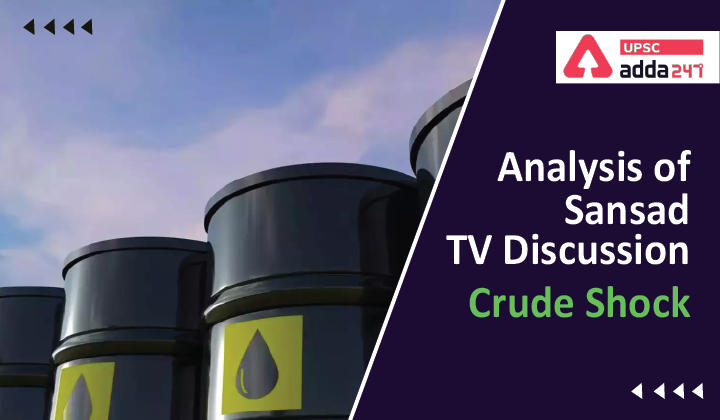Table of Contents
Analysis of Sansad TV Discussion: Crude Shock
Relevance
”GS 3: Mobilization of Resources, Growth & Development, Effect of Policies & Politics of Countries on India’s Interests”
Introduction
- Amidst the ongoing Russia-Ukraine conflict and tightened sanctions on Moscow by western countries, led by the United States, Brent crude price surged to $118.22 per barrel in London, the highest level since February 2013.
- There is a growing expectation that, as the conflict gets more entrenched, crude could remain elevated for much longer and average close to $100/barrel in 2022, vis-a-vis $70/barrel in 2021.
- This would constitute a large, negative term of trade shock to India to the tune of 1.2 per cent of GDP.
About Brent Crude
- Brent crude – also referred to as Brent blend – is one of three major oil benchmarks used by those trading oil contracts, futures and derivatives. The other two major benchmarks are West Texas Intermediate (WTI) and Dubai/Oman, though there are many smaller oil varieties traded as well.
- Brent crude makes up more than half of the world’s globally traded supply of crude oil.
The dominance of Russia in oil
- Russia competes with Saudi Arabia for the title of biggest crude oil and refined oil products exporter, with shipments of more than seven million barrels per day (bpd), about half of which go to Europe.
- In fact, Russia is the world’s largest exporter of oil to global markets and the second-largest crude oil exporter behind Saudi Arabia.
- The share of Russian gas supplies to the EU region has increased from 25% of the total gas demand in 2009 to 32% in 2021.
- Russia is the world’s third-biggest oil (after the US and Saudi Arabia) and the second biggest natural gas (after the US) producer, besides the No. 3 coal exporter (behind Australia and Indonesia).
Importance of oil for India
- We are the hottest market for oil. And there is no other country among large emerging economies which is more vulnerable to high oil prices than India
- India’s tax revenues are heavily dependent on oil. Oil accounts for more than 50% of central excise duties – tax collected on goods produced within the country.
- States depend on oil taxes to shore up their revenues.
- The latest Economic Survey has also projected 8-8.5% growth on the assumption that oil prices would remain between $70-$75 a barrel. Oil prices at anything more than $68-$70 a barrel is bad news for our economy.
How high could oil prices go?
- The disruption caused by the latest measures has raised expectations of oil prices amid from market disruption.
- The oil prices could reach $200 per barrel if Russia is cut off by the West from global oil markets.
- With the US Government indicating the sanctions on Russia’s oil industry are ‘on the table’ the cost could be oil at $200 per barrel, as it would take all of global spare oil production capacity, the return of more Iranian oil in the market, a ramp up in drilling in the US shale industry, and demand destruction from high prices, to replace Russia’s 7-7.5m barrels per day contribution to global oil supply.
Impact on India
- There are several channels through which the Russia-Ukraine conflict will impact India’s economy.
- The first order impact emanates from the negative terms of trade shock from higher commodity prices, particularly oil.
- A direct trade channel to the affected region, an indirect trade channel from weaker global growth, and a tightening of financial conditions and capital flows as global risk appetite wanes.
- An adverse supply shock to the economy simultaneously impacts growth, inflation and the current account deficit (CAD).
- High oil prices also hurt growth and slow down the economy as people end up spending more money on energy and spend less on other things. And when growth sputters, the government’s fiscal calculations can go completely awry.
- The hit to growth in 2022 from oil at $100/barrel can be expected to be between 0.9-1.1 per cent of GDP depending on the burden-sharing between the public and private sectors.
- Growth apart, oil at $100 will leave a tangible imprint on India’s external balances.
Conclusion
How long this war will continue and how high the prices will rise to we don’t know. There’s so much uncertainty. It is like driving in the fog. Per-capita consumption of energy in India is still among the lowest in the world. “The war in Ukraine is a major wake-up call for us to plan our energy security better.



 TSPSC Group 1 Question Paper 2024, Downl...
TSPSC Group 1 Question Paper 2024, Downl...
 TSPSC Group 1 Answer key 2024 Out, Downl...
TSPSC Group 1 Answer key 2024 Out, Downl...
 UPSC Prelims 2024 Question Paper, Downlo...
UPSC Prelims 2024 Question Paper, Downlo...




